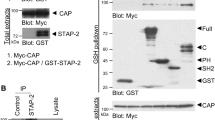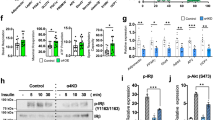Abstract
OBJECTIVE: Insulin-responsive adipogenic signaling molecules include insulin receptor substrates (IRS)-1 and -2, phosphoinositide 3-kinase (PI3K), and protein kinase B (PKB; also known as Akt). Mammalian target of rapamycin (mTOR) is a PKB substrate, and regulates p70 S6 kinase (p70 S6K). Since p70 S6K is an insulin-responsive kinase downstream of PI3K and PKB, its potential role in adipogenic insulin signaling was investigated.
DESIGN: We measured the effect of rapamycin, a specific inhibitor of mTOR, on insulin-induced 3T3-L1 adipogenesis and on insulin-stimulated p70 S6K activation.
RESULTS: Rapamycin partially reduced differentiation, measured by Oil Red O staining, triacylglycerol accumulation (by up to 46%), and peroxisome proliferator-activated receptor γ protein expression (by 50%). In contrast, rapamycin completely inhibited insulin-stimulated p70 S6K activation, assessed by phosphorylation of p70 S6K and its substrate, S6. Expression of a constitutively activated form of p70 S6K did not promote 3T3-L1 adipogenesis. The considerable residual differentiation in the presence of rapamycin, despite the complete blockade of p70 S6K activation, prompted us to measure the phosphorylation of another rapamycin-sensitive protein, eukaryotic initiation factor 4E (eIF4E) binding protein 1 (4E-BP1). Insulin-stimulated 4E-BP1 phosphorylation in 3T3-L1 preadipocytes was only partially affected by rapamycin, consistent with the differentiation data. Phosphorylation of eIF4E itself, an expected consequence of 4E-BP1 phosphorylation, was also only partially inhibited.
CONCLUSION: Our data suggest that adipogenic mTOR signaling occurs via the 4E-BP1/eIF4E pathway, rather than through p70 S6K.
This is a preview of subscription content, access via your institution
Access options
Subscribe to this journal
Receive 12 print issues and online access
$259.00 per year
only $21.58 per issue
Buy this article
- Purchase on Springer Link
- Instant access to full article PDF
Prices may be subject to local taxes which are calculated during checkout





Similar content being viewed by others
References
Montague CT, O'Rahilly S . The perils of portliness: causes and consequences of visceral obesity. Diabetes 2000; 49: 883–888.
MacDougald OA, Lane MD . Transcriptional regulation of gene expression during adipocyte differentiation. Annu Rev Biochem 1995; 64: 345–373.
Chaika OV, Chaika N, Volle DJ, Wilden PA, Pirrucello SJ, Lewis RE . CSF-1 receptor/insulin receptor chimera permits CSF-1-dependent differentiation of 3T3-L1 preadipocytes. J Biol Chem 1997; 272: 11968–11974.
Miki H, Yamauchi T, Suzuki R, Komeda K, Tsuchida A, Kubota N, Terauchi Y, Kamon J, Kaburagi Y, Matsui J, Akanuma Y, Nagai R, Kimura S, Tobe K, Kadowaki T . Essential role of insulin receptor substrate 1 (IRS-1) and IRS-2 in adipocyte differentiation. Mol Cell Biol 2001; 21: 2521–2532.
Sakue H, Ogawa W, Matsumoto M, Kuroda S, Takata M, Sugimoto T, Spiegelman BM, Kasuga M . Posttranscriptional control of adipocyte differentiation through activation of phosphoinositide 3-kinase. J Biol Chem 1998; 273: 28945–28952.
Magun R, Burgering BMT, Coffer PJ, Pardasni D, Lin Y, Chabot J, Sorisky A . Expression of a constitutively activated form of protein kinase B (c-Akt) in 3T3-L1 preadipose cells causes spontaneous differentiation. Endocrinology 1996; 137: 3590–3593.
Kohn AD, Summers SA, Birnbaum MJ, Roth RA . Expression of a constitutively active Akt ser/thr kinase in 3T3-L1 adipocytes stimulates glucose uptake and glucose transporter 4 translocation. J Biol Chem 1996; 271: 31372–31378.
Burgering BMT, Coffer PJ . Protein kinase B (c-Akt) in phosphatidylinositol-3-OH kinase signal transduction. Nature 1995; 376: 599–602.
Reusch JEB, Colton LA, Klemm DJ . CREB activation induces adipogenesis in 3T3-L1 cells. Mol Cell Biol 2000; 20: 1008–1020.
de Groot RP, Ballou LM, Sassone-Corsi P . Positive regulation of the cAMP-responsive activator CREM by the p70 S6 kinase. Cell 1994; 79: 81–91.
Scott PH, Brunn GJ, Kohn AD, Roth RA, Lawrence Jr JC . Evidence of insulin-stimulated phosphorylation and activation of the mammalian target of rapamycin mediated by a protein kinase B signaling pathway. Proc Natl Acad Sci USA 1998; 95: 7772–7777.
Nave BT, Ouwens DM, Withers DJ, Alessi DR, Shepherd PR . Mammalian target of rapamycin is a direct target for protein kinase B. Biochem J 1999; 344: 427–431.
Raught B, Gingras A-C, Sonenberg N . The target of rapamycin (TOR) proteins. Proc Natl Acad Sci USA 2001; 98: 7037–7044.
Yeh W-C, Bierer BE, McKnight SL . Rapamycin inhibits clonal expansion and adipogenic differentiation of 3T3-L1 cells. Proc Natl Acad Sci USA 1995; 92: 11086–11090.
Bell A, Grunder L, Sorisky A . Rapamycin inhibits human adipocyte differentiation in primary culture. Obes Res 2000; 8: 249–254.
Gagnon A, Lau S, Sorisky A . Rapamycin-sensitive phase of 3T3-L1 preadipocyte differentiation after clonal expansion. J Cell Physiol 2001; 189: 14–22.
Gingras A-C, Raught B, Sonenberg N . eIF4 initiation factors. Annu Rev Biochem 1999; 68: 913–963.
Tsukiyama-Kohara K, Poulin F, Kohara M, DeMaria CT, Cheng A, Wu Z, Gingras A-C, Katsume A, Elchebly M, Spiegelman BM, Harper M-E, Tremblay ML, Sonenberg N . Adipose tissue reduction in mice lacking the translational inhibitor 4E-BP1. Nat Med 2001; 7: 1128–1132.
Gagnon A, Chen C-S, Sorisky A . Activation of protein kinase B and induction of adipogenesis by insulin in 3T3-L1 preadipocytes. Contribution of phosphoinositide-3,4,5-trisphosphate versus phosphoinositude-3,4-bisphosphate. Diabetes 1999; 48: 691–698.
Cianflone K, Roncari DAK, Maslowska M, Baldo A, Forden J, Sniderman AD . Adipsin/acylation stimulation protein system in human adipocytes: regulation of triacylglycerol synthesis. Biochemistry 1994; 33: 9489–9495.
Dennis PB, Pullen N, Pearson RB, Kozma SC, Thomas G . Phosphorylation sites in the autoinhibitory domain participate in p70S6K activation loop phosphorylation. J Biol Chem 1998; 273: 14845–14852.
Pear WS, Nolan GP, Scott ML, Baltimore D . Production of high-titre helper-free retroviruses by transient transfection. Proc Natl Acad Sci USA 1993; 90: 8392–8396.
Bell A, Gagnon A, Grunder L, Parikh SJ, Smith TJ, Sorisky A . Functional TSHR receptor in human abdominal preadipocytes and orbital fibroblasts. Am J Physiol: Cell Physiol 2000; 279: C335–C340.
Laemmli UK . Cleavage of structural proteins during the assembly of the head of bacteriophage T4. Nature 1970; 227: 680–685.
Gingras AC, Gygi SP, Raught B, Polakiewicz RD, Abraham RT, Hoekstra MF, Aebersold R, Sonenberg N . Regulation of 4EBP-1 phosphorylation: a novel two-step mechanism. Genes Dev 1999; 13: 1422–1437.
Shao D, Lazar MA . Peroxisome proliferator activated receptor g, CCAT/enhancer-binding protein a, and cell cycle status regulate the commitment to adipocyte differentiation. J Biol Chem 1997; 272: 21473–21478.
Tang Q-Q, Otto TC, Lane MD . Mitotic clonal expansion: a synchronous process required for adipogenesis. Proc Natl Acad Sci USA 2003; 100: 44–49.
Usui I, Haruta T, Iwata M, Takano A, Uno T, Kawahara J, Ueno E, Sasaoka T, Kobayashi M . Retinoblastoma protein phosphorylation via PI 3-kinase and mTOR pathway regulates adipocyte differentiation. Biochem Biophys Res Commun 2000; 275: 115–120.
Shima H, Pende M, Chen Y, Fumagalli S, Thomas G, Kozma SC . Disruption of the p70S6K/p85S6K gene reveals a small mouse phenotype and a new functional S6 kinase. EMBO J 1998; 17: 6649–6659.
Templeton DJ . Protein kinases:getting NEKed for S6K activation. Curr Biol 2001; 11: R596–R599.
Lin T-A, Kong X, Haystead TAJ, Pause A, Belsham G, Sonenberg N, Lawrence Jr JC . PHAS-1 as a link between mitogen-activated protein kinase and translation initiation. Science 1994; 266: 653–656.
Lin TA, Kong X, Saltiel AR, Blackshear PJ, Lawrence Jr JC . Control of PHAS-I by insulin in 3T3-L1 adipocytes. J Biol Chem 1995; 270: 18531–18538.
Gingras A-C, Kennedy SG, O'Leary MA, Sonenberg N, Hay N . 4E-BP1, a repressor of mRNA translation, is phosphorylated and inactivated by the Akt(PKB) signaling pathway. Genes Dev 1998; 12: 502–513.
Harbour JW, Dean DC . The Rb/E2F pathway: expanding roles and emerging paradigms. Genes Dev 2000; 14: 2393–2409.
Blume-Jensen P, Hunter T . Oncogenic kinase signalling. Nature 2001; 411: 355–365.
Huffman TA, Mothe-Satney I, Lawrence Jr JC . Insulin-stimulated phosphorylation of lipin mediated by the mammalian target of rapamycin. Proc Natl Acad Sci USA 2002; 99: 1047–1052.
Acknowledgements
This work was supported by a grant from the Canadian Institutes of Health Research. AS is a Career Investigator of the HSFO. AG is supported by a Premier's Research Excellence Award held by AS. DE-C was supported by a John D Schultz Science Student Scholarship of the HSFO. We thank Thet Crapper for technical assistance.
Author information
Authors and Affiliations
Corresponding author
Rights and permissions
About this article
Cite this article
El-Chaâr, D., Gagnon, A. & Sorisky, A. Inhibition of insulin signaling and adipogenesis by rapamycin: effect on phosphorylation of p70 S6 kinase vs eIF4E-BP1. Int J Obes 28, 191–198 (2004). https://doi.org/10.1038/sj.ijo.0802554
Received:
Revised:
Accepted:
Published:
Issue Date:
DOI: https://doi.org/10.1038/sj.ijo.0802554
Keywords
This article is cited by
-
Orobol, an Enzyme-Convertible Product of Genistein, exerts Anti-Obesity Effects by Targeting Casein Kinase 1 Epsilon
Scientific Reports (2019)
-
The application of transcriptomic data in the authentication of beef derived from contrasting production systems
BMC Genomics (2016)
-
Adipocyte-specific deletion of mTOR inhibits adipose tissue development and causes insulin resistance in mice
Diabetologia (2016)
-
The multifaceted role of mTORC1 in the control of lipid metabolism
EMBO reports (2013)
-
Impact of transient correction of increased adrenocortical activity in hypothalamo-damaged, hyperadipose female rats
International Journal of Obesity (2006)



